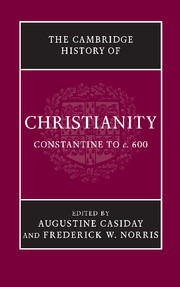Book contents
- Frontmatter
- Introduction
- Part I Christianity: Regional Developments
- Part II Christianity Contested
- 5 Religious dynamics between Christians and Jews in late antiquity (312–640)
- 6 Christianity and paganism, I: Egypt
- 7 Christianity and paganism, II: Asia Minor
- 8 Christianity and paganism, III: Italy
- 9 Christianity and paganism, IV: North Africa
- 10 The intellectual debate between Christians and pagans
- 11 Christianity and Manichaeism
- 12 Heresiology: The invention of ‘heresy’ and ‘schism’
- Part III Christian Culture and Society
- Part IV Christian Beliefs and Practices
- Index
- Map 1 The Roman empire, c. 400">
- References
12 - Heresiology: The invention of ‘heresy’ and ‘schism’
from Part II - Christianity Contested
Published online by Cambridge University Press: 28 March 2008
- Frontmatter
- Introduction
- Part I Christianity: Regional Developments
- Part II Christianity Contested
- 5 Religious dynamics between Christians and Jews in late antiquity (312–640)
- 6 Christianity and paganism, I: Egypt
- 7 Christianity and paganism, II: Asia Minor
- 8 Christianity and paganism, III: Italy
- 9 Christianity and paganism, IV: North Africa
- 10 The intellectual debate between Christians and pagans
- 11 Christianity and Manichaeism
- 12 Heresiology: The invention of ‘heresy’ and ‘schism’
- Part III Christian Culture and Society
- Part IV Christian Beliefs and Practices
- Index
- Map 1 The Roman empire, c. 400">
- References
Summary
Heresiology was the combative theological genre for asserting true Christian doctrine through hostile definition and ecclesiastical exclusion. In the fourth to sixth centuries the union of Christian orthodoxy with Roman political power can easily seem to modern eyes to be a bad match. Emperors peeved by the inability of religious practitioners to come to an enforceable consensus for the protection of the state worked with bishops increasingly polarised by local traditions and civic unrest in a high stakes game of imperial orthodoxy. The unprecedented Roman imperial legislation on religious dissent was entwined with the general expansion of bureaucracy and law in the later empire. In this political context heresy was increasingly no longer only an ecclesiastical matter or a serious theological challenge, but a problem of public safety since correct belief and worship ensured the unity and stability of society. Heresiological categories were often a means to establish or maintain common boundaries. The development of creeds and imperial law, however, was matched by an increasing theological and political complexity so that conflicts in at least North Africa, Syria and Egypt persisted due to regional concerns and local theological traditions.
The literary genre of heresiology shifted in this era as older Christian sectarian structures gave way to ecumenical councils and increasingly sophisticated theological definitions. Heresiology can be read as the political claim of an exclusive ideology made through the demonisation, exclusion and silencing of ‘the other’. Ironically, this can simply be the negative reading of the apologetic historical narrative that presented an evolutionary orthodox core that was defended from incursions. Actual historical practice did not match the analytical clarity of this binary category.
Keywords
- Type
- Chapter
- Information
- The Cambridge History of Christianity , pp. 296 - 314Publisher: Cambridge University PressPrint publication year: 2007
References
- 9
- Cited by

